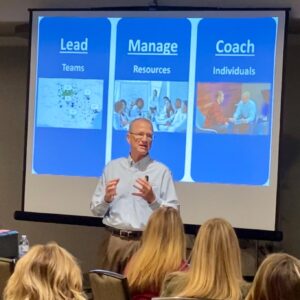How to differentiate yourself from all those competitors who are out there “winging it”!
“Well, we bombed that one,” Ken blurted out as soon as we were back in the pick-up.
“We?” I jabbed back with a smile to lighten the mood a bit.
“I botched it bad. I have all that information he was looking for; I just didn’t bring it!” Ken went on. After a few more minutes of Ken telling me how he knew exactly what this producer was going to do, say and ask on the sales call, my follow up question of Ken was too easy to miss.
“Well, if you knew all that, how did you prepare for it?”
With that question, Ken went through a series of different facial expressions. Anger at himself, guilt for not preparing for what he knew was going to happen. A contemplative expression came next as Ken was trying to come up with a good excuse for not preparing better.
After planning thousands of sales presentations and working with hundreds of salespeople on theirs over the years, I see a common thought process for how salespeople prepare.
I call it “Selling on a Wing and a WIM:
Here’s the inner dialogue that we go through:
- 2 weeks out: “I have an important sales call with Evans Dairy coming up. I need to get ready for it”
- 1 week out: “That’s an important call with Evans Dairy, I really need to prepare. Wonder if I could get our nutritionist out there as I’m not ready to present on the technical part of the program yet”.
- 2 days out: “I spent the whole day dealing with computer issues on my laptop, a feed fines complaint and a mandatory conference call on the new wellness program. I have nothing done on preparing for the Evans Dairy sales call.”
- 6:30 a.m. on the day of the call: “Ok, let me get some of the data downloaded and printed. I can conference in Dr. Steve (our nutritionist) if Evans Dairy hits me with anything too technical.”
- Top of the driveway in front of Evans Dairy: I reach into my backpack in the back seat. I pull out the file folder for Evans Dairy. Looking at my previous notes, I realize they wanted me to bring back a dry cow program. Oops! I am all prepared with the latest and greatest lactation diets. “Too late now. Gonna have to Wing it!”
Every salesperson wants to feel like they have the ability to deliver a great sales presentation. And, every salesperson feels that when it falls apart or they are not prepared, they will be able to just “wing it”. The effects of winging it are less sales, less likely to get a next appointment, and unanswered questions, which doesn’t allow you to come back and position better products.
When I watch salespeople “Wing it”, often they use what I call the WIM formula.
W – We have some great products!
I – I think you are going to like them!
M – Let Me tell you all about them!
The 4 R’s
- wRite: I know it doesn’t start with an R, but it’s close.
Put your plan in writing. Ken did some minor planning, but he didn’t have anything in writing. He went in and “Winged it”.
With no written plan, agenda, nor key questions, he allowed the customer to set the topics. These were rambling topics unrelated to the products Ken was selling.
Did we “make a sales call”? Sure.
Did we survive to come back another day with this prospect? Probably.
Is this prospect going to be excited about granting us another appointment when Ken calls him in a few weeks to “Check in”? No! Hard pass. I will not be surprised if the prospect throws several excuses on why she can’t meet with us.
- Rehearse:
Yes, I am actually recommending that you rehearse your presentation. You would be amazed at how different the written words sound when you speak them. For an even better rehearsal experience, take your I-pad or phone out and record it. Three revelations will hit you as you watch the recording. First, you will be shocked by how your message comes across. Second, you will be extremely thankful you didn’t go in and present that version of your presentation. Lastly, you will be amazed at how much better your message is received when making the actual sales presentation.
A common misconception about rehearsing in sales is that we think it might make us look robotic as if we are reading a script. In fact, the exact opposite is true. When you rehearse, you’re not memorizing. You’re working off your PowerPoint, your handouts, your props. You will be more comfortable with them. You will be more fluid and conversational in your delivery. Most importantly, rehearsing will give you a boost of confidence in your presentation.
It’s not necessary to rehearse those parts of your presentation that you are extremely fluent in. Most salespeople are good at talking about their products. No need to rehearse. However, rehearse anything new or different in your presentation, especially props. When I say props, I’m referring to your handouts, your I-pad, your computer programs, any samples you bring for demonstration purposes. Unless you’re Billy Joel or John Legend demonstrating the piano, you need to rehearse with your props. Lastly, please don’t get out on the farm, pull out the computer program and then commence to making excuses about how you don’t know how to run the technology. Stop wasting your prospect’s valuable time while you learn how to operate your material!
What if the pilot on your next flight came on the intercom and said, “Folks, we are slightly delayed but will be on our way soon. I’m just a little confused on all these dials and gauges. They’re changing these things every day. We’ll figure it out in the air!” You would be upset the pilot didn’t figure out how to fly this plane prior to climbing into the cockpit. Your customer feels the same way.
- Rewriting
There’s an old saying amongst comedians, “Great jokes aren’t written. They are rewritten.” Watching the recent Jerry Seinfeld special, he discussed writing and rewriting a joke for 18 years before he got it just right. That’s a bit excessive for our purposes, but he is making a good point. Rarely do we come right out of the gate with the perfect presentation.
Once written, and rehearsed, go back and edit (rewrite) those parts that aren’t crystal clear. Trust me, if something doesn’t seem right when you are in the quiet of your home office, it’s going to be even worse when you are under the spotlight of the customer’s stare.
- Role-Play
The ultimate form of rehearsing.
After every sales training workshop I hold, the feedback forms come in. Summarizing the comments and tallying the evaluation scores, I can almost guarantee there will be two comments about role-play on their evaluation forms. First, they will say role-play was the #1 thing they didn’t like. However, their second comment will be that they learned the most from the role-plays and wished we spent more time on them. So, there you go. They hate it, but they feel it’s the best learning tool. So, it stays in. There is nothing more realistic except an actual customer sales call. With instructions built into my role-play scenarios and a moderate amount of “staying in character”, the role play really is the last proving ground before they go out and meet with their customer.
There is not enough time in the day to use all four R’s for every presentation. Focus is your key to getting these important steps into your selling process. Narrow it down by using these four R’s on the most important sales calls, on those parts of the presentation that are new, different or that you stumble on.
In Ken’s case, it was obvious as we drove out of the producer’s driveway. Prepare for the most likely scenario. Ken knew what the producer wanted. He knew what the producer was going to ask.
All he needed was the 4 R’s to have a much more productive presentation.




